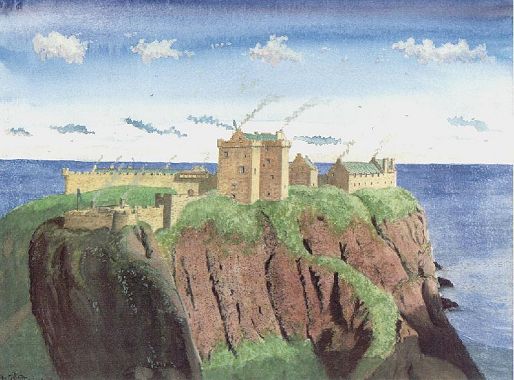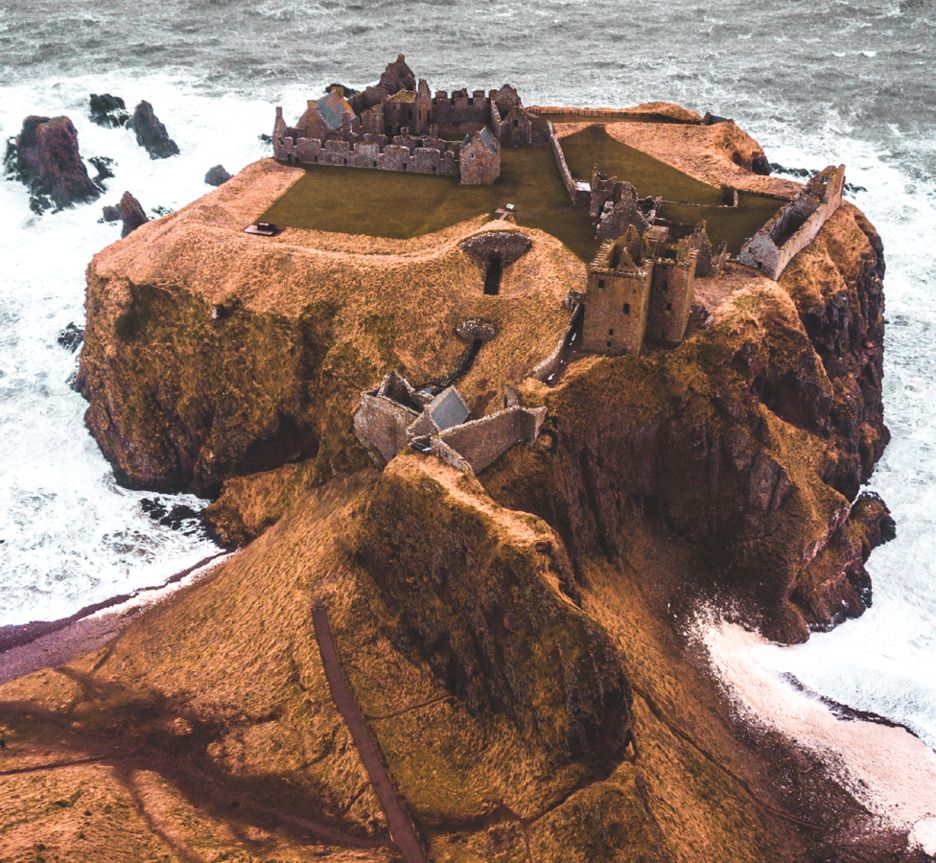
This image is the copyright of Andrew
Spratt who has generously given permission to display it here.
Dunnottar Castle is a dramatic and evocative ruin. As you wander around
the extensive buildings you are almost surrounded by sea with gulls and
other seabirds wheeling and screaming around the cliffs below you. If the
outline is a little familiar, this may be because Dunnottar Castle was the
location for the 1990 film version of Hamlet starring Mel Gibson.
Even if there was no castle at Dunnottar, the site would immediately
catch the eye - an enormous flat-topped rock with sheer cliffs on three
sides. This site was chosen in Pictish times as place of strength and by
Saint Ninian as a place of retreat. Dunnottar is more than a topographical
curiosity since this rock and the buildings on it have reflected in
miniature much of the rich and tragic story of Scottish history. William
Wallace, Mary Queen of Scots and the Marquis of Montrose have all graced
the Castle with their presence. Most famously though, it was at Dunnottar
Castle that a small garrison held out against the might of Cromwell's army
for eight months and saved the Scottish Crown Jewels, the 'Honours of
Scotland', from destruction.
From the car park the dominant building viewed is the 14th century Keep
or Tower House, a little battered by Cromwell's cannons, but still intact.
This is just one of the eleven different buildings which comprise
Dunnottar Castle which also includes barracks, lodgings, stables and
storehouses.
At the far end of the rock, in sharp contrast to the old tower, is an
elegant quadrangle. This is bounded on three sides by domestic buildings
of the 17th century, including, for its time, one of the largest ballrooms
in Scotland extending to some 35 metres. The fourth side is formed by the
Castle's 13th century chapel - a relic of the time that William Wallace
burnt the early wooden Castle with the occupying English garrison inside.
The chapel, one of the very few stone buildings, has survived to tell the
tale.
Dunnottar Castle was the home of the Earls Marischal of Scotland, once
one of the most powerful families in the land. The Earl Marischal oversaw
all ceremonial activities in the Scottish Court, including the
coronations. He was also responsible for the security of the Scottish
Crown Jewels, known as the 'Honours of Scotland'. The story of how a small
garrison in Dunnottar Castle saved the Honours of Scotland from certain
destruction is one of the most captivating in Scottish history.
Charles I, King of both Scotland and England, was executed in 1649 by
Oliver Cromwell. The following year his son (later Charles II) arrived in
north east Scotland in a bid to retake the two kingdoms and on his journey
south he stayed overnight at Dunnottar Castle. However, in England, Oliver
Cromwell was so enraged at the young King's arrival he invaded Scotland.
In some haste therefore, Charles II was crowned at Scone, but the crown
and the other coronation regalia could not be returned to Edinburgh Castle
which had now been taken by Cromwell's army. The English crown jewels had
already been destroyed by Cromwell and the Honours of Scotland, the most
potent remaining icon of the monarchy, were next on his list. His army was
fast advancing on Scone and the King ordered the Earl Marischal to secure
the Honours and many of his personal papers at Dunnottar Castle.
It was not long before Dunnottar was under siege and a scratch garrison
of 70 men held out for eight months against the invading forces. Its
unique position made the Castle impregnable to infantry attack, but when
the heavy cannons finally arrived and began to raze the major buildings,
the situation became untenable. Before surrender was contemplated,
however, the King's papers were taken through the besieging forces by a
brave young lady acquaintance of the Governor who secured them around her
waist. The crown, sceptre and sword meanwhile, had been lowered over the
seaward side of the Castle and received by a serving woman, there on
pretence of gathering seaweed. They were thereafter taken to the church at
Kinneff, a village several miles to the south where at first they were
hidden at the bottom of the bed in the minister's house until he could
bury them more securely in the kirk. There they remained undiscovered for
eleven years.
A darker chapter in the history of Dunnottar is that of the 'Whig's
Vault'. Visitors can still see the gloomy, airless cellar where in 1685 a
body of Covenanting prisoners, 122 men and 45 women, were held without
food or sanitation from 24 May to the end of July. Their crime was that
they had refused to acknowledge the King's supremacy in spiritual matters.
Twenty brave souls attempted to escape, fifteen of whom were recaptured
and tortured. The remainder were eventually transported to the West
Indies. Amongst the prisoners were a Charles and a William Douglas,
who were transported on the Henry and Francis to Perth Amboy, New Jersey.
The Castle never recovered from Cromwell's attentions and although it
was later a garrison for troops, it no longer had its former glory. The
last Earl Marischal was convicted of treason for his part in the Jacobite
rising of 1715 and his estates, including Dunnottar Castle, were seized by
the government. The buildings were thereafter neglected until 1925 when
the 1st Viscountess Cowdray embarked on a systematic repair of the Castle.
It has remained in private family ownership ever since.

Elizabeth Douglas (dau
of John Douglas, 2nd Earl of Morton)
m. (1505) Robert
Keith, Master of Marischal (dvp after 1513)
Archibald
(Sir) (2nd of Glenbervie) Douglas married Agnes (Anne) Keith, c1531
Sir
William Douglas, 7th Earl of Morton married, 28 MAR 1604,
Ann Keith
Anne, daughter of William Douglas,
9th Earl of Morton,
married William (6th Earl Marischal) Keith b: 1614
William
Douglas, 6th Earl of Morton (b 1582, d 07.08.1648) married (mcrt
05.03.1604) Anne
Keith (d 1648)
|
|


